Don't wanna be here? Send us removal request.
Text
Group Timeline Project
For the group timeline project we were faced with the task of researching a list of key moments in the evolution of visual communication. My chosen subject is illustration but for this task we were teamed up with people from animation and gaming. I feel we worked really well as a team. I set up a Facebook group chat as soon as I learned who was in my team to ease any communication difficulties. We decided as a team as there were 5 of us and 20 subject we would divide the topics fairly and have 4 each. My task was to research the historical, cultural and economic impact of the following key moments to the evolution of visual communication.
Der Delstein - Der Edelstein (The Precious Stone) published by Albreht Pfister in 1461 and is a book of fables. It has been selected by scholars as being historically and culturally important because it is the first know book to be printed with both text and illustrations using woodcut printing techniques.
Daguerreotype - The daguerreotype process, or daguerreotype, was the first publicly available photographic process
The Arts and Crafts Movement - The Arts and Crafts movement emerged from the attempt to reform design and decoration in mid-19th century Britain. It was a reaction against a perceived decline in standards that the reformers associated with machinery and factory production caused by the Industrial Revolution.
COVID-19 - COVID-19 is a highly infectious disease caused by a newly discovered coronavirus. The first case of COVID-19 was reported to the World Health Organisation (WHO) in December 2019. COVID-19 spreads primarily through droplets from the mouth and nose when an infected person coughs or sneezes.
Using Facebook messenger as our mode of communication we also used Google Jamboard to create our digital timeline. I personally have never used Google Jamboard before but I found it to be very user friendly and we all picked it up rather quickly. As it is an online tool it meant we could add all our findings to the Jamboard and everyone could view what we found. The day before the project was due to be presented we gathered as a group on Webex after our Wednesday college class had finished and worked as a team to finalise the layout and decide how we were going to present. As there were 5 of us in the team and we were limited to a 5 minute presentation as a group, we decided to present 1 of our 4 so we could achieve the goal of a 5 minute presentation. We decided to present to the class our findings in chronological order.
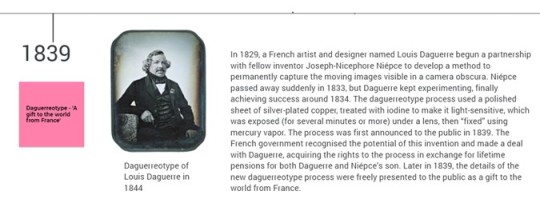
Extract from group project ‘Timeline’ showing ‘The Daguerreotype’
0 notes
Text
Cultural and Economic Importance of Illustration Sector
The Statue of Anne
The Statue of Anne, also known as the Copyright Act 1710 is an act of the parliament of Great Britain and was the first statute to provide for copyright regulated by the government and courts rather than by private agencies. At the time of Statute of Anne, copyright only lasted for 14 years. The act was established “for the encouragement of learned men to compose and write useful books”. The Statute of Anne allowed authors to earn a living from their work. The act formed the beginning of copyright protection and copyright law. This pivotal moment still holds great importance in today’s world as copyright laws protect lots of creative industries including illustrators.

Extract from group project ‘Timeline’ showing ‘The Statute of Anne’
COVID-19
COVID-19 is a highly infectious disease caused by a newly discovered coronavirus. The first case of COVID-19 was reported to the World Health Organisation (WHO) in December 2019. COVID-19 spreads primarily through droplets from the mouth and nose when an infected person coughs or sneezes.
COVID-19 has had a huge impact economically on a lot of industries including the creative sector. The creative sector has felt the economic hit due to closures of galleries , entertainment venues etc because of government enforced “lockdowns”. The creative sector banks heavily on disposable incomes. As of October 2020 9.6 million people in the UK had been on the government funded “job retention scheme” commonly known as furlough. The government paid 80% of furloughed employees wages from March-August. This meant that many members of the public have had a reduction in income meaning they may have to pause disposable income spending.

Extract from group project ‘Timeline’ showing ‘COVID-19’
0 notes
Text
Historical Development in Illustration
From early cave paintings to the examples digital illustrations we see today, illustration has come a long way over the years!
The Lascaux Caves
Starting at the beginning the Lascaux Caves are a series of caves first discovered in 1940, located in southwestern France. Over 600 parietal wall ‘cave art’ paintings have been discovered on the ceiling and interior walls of the caves. The paintings are mostly of animals and the age of the paintings are thought to be around 17,000 years old. Their importance in the historical development of the illustration sector is because they are thought to be one of the earliest examples of man made illustration.

Extract from group project ‘Timeline’ showing ‘The Lascaux Caves’
Middle Ages
In the Middle Ages, narrative pictorials appeared in illuminated manuscripts. Christians believed the sanctity of religious writings were the main reason for the preservation of books and the writing, copying and illuminating of books happened in places called ‘scriptoria’ in monasteries.
Der Edelstein
Der Edelstein (The Precious Stone) was published by Albreht Pfister in 1461 and is a book of fables. It has been selected by scholars as being historically and culturally important because it is the first know book to be printed with both text and illustrations using woodcut printing techniques.
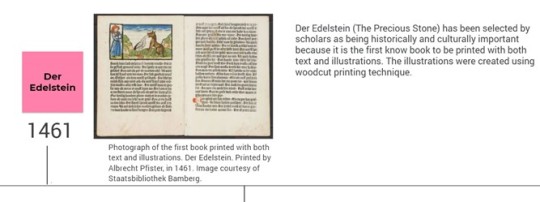
Extract from group project ‘Timeline’ showing ‘Der Edelstein’
The Industrial Revolution
The Industrial Revolution was the transition to industrialised and urban manufacturing processes in Europe and the United States. With the start of the Industrial Revolution in the mid 1700′s, printing technology improved and illustration became more commonly encountered in everyday life. English wood engraver and publisher Thomas Bewick built himself a studio for the creation and printing of commercial illustrations that were used for many purposes suck as educational materials in schools and children’s books.
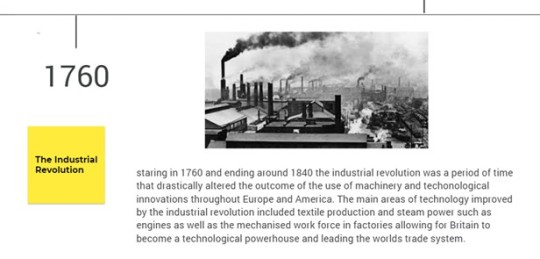
Extract from group project ‘Timeline’ showing ‘The Industrial Revolution’
18th Century
In the early 1800′s the profession of being an illustrator became a full-time reality with sales of etched or engraved prints through print shops and street side book stalls. This made illustration widely available and affordable. Publications by Charles Dickens and other popular writers soon became fully illustrated. Due to more efficient distribution networks, illustrated newspapers, books and full-colour newspaper comics became an affordable source of entertainment.
Steamboat Willie
Walt Disney established himself in the illustration sector by making popular cartoon shorts such as Steamboat Willie in 1928. Steamboat Willie was also the first cartoon with sound. This advancement lead to the creation of full-length animated feature films. Snow White in 1937 and Pinocchio in 1940. Both Snow White and Pinocchio took 4 years to produce!
Good Housekeeping
The magazine publishing industry grew rapidly in the 1950s after the Great Depression and both World Wars. The 1950s was the birth of Women’s magazines era with publications such as Good Housekeeping and Cosmopolitan.
Digital Animation
In the 20th century, Walt Disney evolved from feature films into digitally animated films and this is when Disney Pixar was born. Disney Pixar produced modern classics such as Toy Story and Finding Nemo. The gaming industry also evolved significantly and technological advancements lead to video games such as Final Fantasy. The publishers of Marvel comics entered into the movie scene with both live-action and animated features. The relationship between the gaming industry, comic industry and film industry become more connected and illustrators played an important role in many aspects of production.
iPad
Apple wished to create a device that was between a laptop and a smartphone. The iPad was born in 2010 and was designed to be better at web browsing and email. The iPad didn’t receive good reviews to begin with and was expected to be a flop for Apple. Wired Magazine labeled it “little more than a giant iPhone.” Apple went on to sell 300,000 iPads in the first few days of it’s release and it broke 2,000,000 sales within two months. What started as a device for web browsing and email has now created a new wave of illustrators. Thanks to technological advancements in the iPad and development of applications such as Procreate, accessories from Apple in the form of the Apple Pencil it has meant that illustrators can create a revolutionary new type of art making it very easy for them to share their work digitally on social media platforms increasing their engagement with consumers.
0 notes
Text
Class Debate
For the class debate we were faced with the task of researching Banksy vs Full Colour Black – a trademark dispute involving graffiti artist Banksy and print company Full Colour Black. I was placed into subgroup B and we were given the task of defending Full Colour Black – a small UK print company that sell postcards of various graffiti-based artwork.
I felt as a group we worked very well together (even with the challenge of a different time zone thrown into the mix!) Due to COVID-19 we haven’t been able to carry out learning at campus so have been attending lectures online from home. This meant that our group task would be online too. I found this to be a blessing and a curse. It was useful that we were able to contact each other as a group via Whatsapp (a communication app). We were able to discuss our strengths and weaknesses and delegate tasks fairly. I was given the task of research. I spent a lot of time carrying out internet based research into the case which I found fascinating. I knew a little bit about the case from reading it on the news but I thoroughly enjoyed reading into it further. We decided the best way for us to present our task would be via PowerPoint presentation. I have not used PowerPoint in many years so I was unaware of the sharing feature. It meant that all four members of the group could remotely access the PowerPoint at any time and add input to the slides. Anytime I added my findings to the slides I would notify my group of any changes made via Whatsapp.I will admit there was a sprint finish at the end to get the PowerPoint finished in time for class – I would definitely have done that part differently as it was very stressful for me leaving it to the last minute as I like to be organised. I don’t like to be a ‘bossy boots’ and feel like I am pushing my classmates to do work when I fully understand everyone has a lot of work to do for all of our classes but in future I will work on my confidence to guide my group into completing work ahead of schedule.
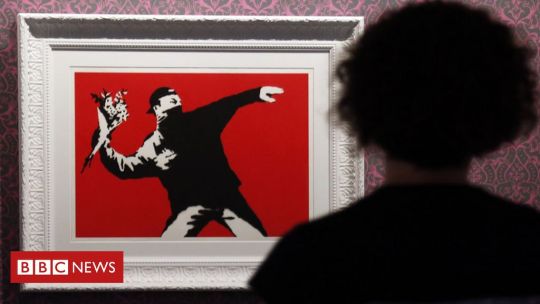
© Image of ‘Flower Bomber’ by Banksy from bbc.co.uk
0 notes
Text
Copyright and Plagiarism in the Illustration Sector
Copyright and plagiarism are so important in the illustration sector because at the end of the day it could potentially lead to an economic hit. Us humans don’t like to believe that ‘money makes the world go round’ but we do need money to live (artist or not!) As an illustrator we put our everything into our work, our handiwork has a massive sentimental value to us so it be only but fair that we benefit fully from our creations. Some might see it as an honour that someone thinks our creations are so wonderful that they wish to copy it for economic gain but this is morally wrong in my opinion - credit where credit is due!
Take Banksy’s ‘Flower Bomber’ trademark dispute. Banksy clearly states on his website that you may use any of his work as long as you do not use it for financial gain yet printing company Full Colour Black used his ‘Flower Bomber’ image on postcards to sell for a profit.
All is not lost in the creative industry as there is a professional organisation that is here to help us illustrators in UK – Association of Illustrators. All the Association of Illustrators ask of you is -
“As a member of the AOI, you will conduct business competently, with integrity and honesty”. – Association of Illustrators
The Association of Illustrators takes the view on copyright and plagiarism very seriously. I am not a member of this association so I couldn’t gain full access to their website but I did however find this statement.
If your illustrations. If someone else makes a copy without your permission, they are infringing your copyright. Copyright in your illustration is an economic right.” – Association of Illustrators
I found this particularly interesting article about copyright infringement on the Graphic Artists Guild website that explains the case of illustrator Ally Burguieres and one of her illustrations being used unlawfully by pop singer Taylor Swift. Ally Burguieres found out that one of her illustrations had been used on Taylor Swift’s social media accounts. The artwork used by Taylor Swift was a copy of Ally Burguieres illustration that she sells as a print and the Taylor Swift fan had copied the image of a fox and signed it with their own name rather than crediting Ally Burguieres. Taylor Swift posted a screenshot of the fan’s Instagram post to her own Twitter, Tumblr and Instagram accounts to promote her ‘1989’ tour. After a yearlong legal battle with Taylor Swift’s representatives, Ally Burguieres stated on her Facebook account that Taylor Swift had removed the posts from her social media accounts and she was offered a four-figure compensation with the agreement that Ally Burguieres donated the full amount to an animal charity. Ally Burguieres declinded the offer since it did not meet her request that her work be credited to her.
If you wish to read the whole article you can do so by following this link.
https://graphicartistsguild.org/copyright-infringement-dispute-highlights-issues-of-plagiarism-on-social-media/

© Image showing comparison between Ally Burguieres original work and the fan post Taylor Swift shared to her social media accounts from graphicartistsguild.org
0 notes
Text
The Principle Concepts of Intellectual Property
Intellectual Property – Intellectual property is the result if a creation of the human mind. An idea is not intellectual property but it is something that is physically created. Examples of intellectual property include inventions, illustrations, designs, logos and images use by a business in commerce.
Copyright – Copyright is a legal protection given to some kinds of intellectual property. It is the exclusive right the originator is given to make copies of creative works produced for a fixed amount of years. Creative works can be of an artistic, literacy or musical form.
Author/ Artist/ Creator – In UK copyright law, a work is considered original if it’s creator uses their intellect, time and effort to create the work.
Plagiarism – Copyright only protects an idea that has been physically created. Plagiarism is taking another person���s work or idea and passing it off as their own without acknowledging the original creator or obtaining their permission. Plagiarism is not illegal but it is morally incorrect. There is no legal protection.
Public Domain – Public domain are works that are available to the public in the public domain and are not subject to copyright or other legal restrictions. An individual does not require a license or fee to use works that have been placed in the public domain. For example NASA has gifted their space photography to the public domain. NASA have stated that their material may be used for educational use but must not be used for commercial use.
Work for Hire – Work for hire is a legal contract when a creation whose copyright is owned by the employer/client of the person who was employed/ commissioned to produce a particular creation.
License – To license means creating a legal contract between the copyright owner and the new user which sets out what the new user can and cannot do with the creation. The contract will usually state the period of time the contract is valid for.
Copyright Infringement – Copyright Infringement is the use of works protected by copyright law without permission from the original creator, whether it be the whole or part of the copyright works are used.
Fair Dealing (UK) Fair Use (USA) – In the UK there is no statutory definition of fair dealing however the idea of fair usage exists within UK copyright law. It is designed to allow the lawful and fair use of work without infringing on the copyright owner. In a court of law each case would be reviewed individually on a case by case basis.
Moral Rights – Moral rights protect the non-economic interests in regards to copyright works. Often copyright works need protection in ways that are different to traditional forms of property. Copyright works often mean more than just their economic value as the works can have sentimental value to the creator as they have invested a lot into their works emotionally and intellectually.
There are four moral rights recognised in the UK
1. The right to attribution
2. The right to object to derogatory treatment of a work
3. The right to object to false attribution
4. The right to privacy of certain photographs and films

© Image – ‘A Clear View of the Scottish Highlands’ from NASA.com A view of the home land from space. NASA kindly release all their images from space into the public domain, you could call it NASA’s gift to the world :)
0 notes
Text
Visual Arts and Me
I have enjoyed arts and crafts from a very young age. I was never very academically minded during my school years but give me some paper and paints and a smile would soon appear on my face. When it came to making course choices in secondary school I ditched as many of the less hands on and creative courses as quickly as I could, instead choosing subjects such as product design, graphic communication, art and design and music.
Being the most indecisive person I am (and still am!) when my secondary school education time was up it was time to answer the age old question of ‘What do I want to be when I grow up?’ So I proceeded to study hairdressing – didn’t enjoy it as much as I had hoped. Let’s try Architecture! It is something I have always been interested in after all. After 4 years of studying into the small hours of the night and many a stressful tear shed it was graduation and time to step foot into the big world of work. We are now in 2020 with nearly 7 years of architectural experience under the belt something out of the blue hit us. Covid-19. March 23rd and Prime Minister Boris Johnston, tells us not to go to work the following day. During month number 4 I am dealt some devastating news. I’m being made redundant. Now what do I do? Can I find another company that will take me under their wing during a pandemic causing financial uncertainty? Short answer – no. After speaking to friends and family I see the silver lining in this unfortunate circumstance I’ve found myself in. This could be the perfect opportunity to retrain and try something else! So after reading the prospectus for my local university I apply to study Visual Communication, a course that covers a lot of modules that are of interest to me. Fast forward to present day and I’m now in week 3 of this course and really enjoying it – finding my feet and realising I 100% made the right decision.
When I applied for the Visual Communication course I was asked to show some examples of my work. I creative a lot of my work as gifts for friends and family but I always take a picture on my smartphone thankfully! I am my own harshest critic – I know I am pleased with something when it makes it to my personal Instagram page!
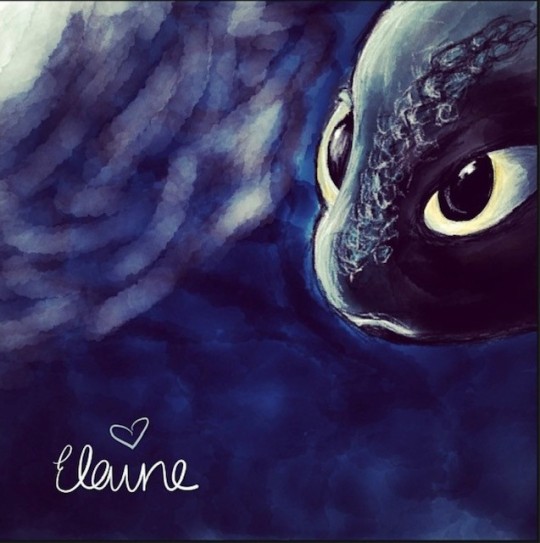
© Image of a Dragon by E.J Fraser
0 notes
Text
My Love For Illustration
My love for illustration I guess begun when it does for a lot of people – when they were a young child being read stories at bedtime. Following the eye-catching, colourful, thought-provoking drawings as a parent read to you. My favourite bedtime story as a child was Roald Dahl’s ‘Matilda’, illustrated by Quentin Blake. ‘Matilda’ is a story about a young girl who is very clever and uses for magical powers for the greater good. Her life is made incredibly difficult by her unloving parents and her strict headmistress Miss Trunchbull.
Now I have a child of my own I was blessed with the opportunity of role reversal and it was now my time to read the stories at bedtime. My daughter’s favourite book when she was little was ‘The Gruffalo’, written by Julia Donaldson, illustrated by Axel Scheffler. A charming story about a mouse’s walk ‘through the deep, dark wood’ on his way to meet a mythical friend ‘The Gruffalo’ for dinner. It really is a lovely book and I can understand why she enjoyed it so much with its brightly coloured illustrations and use of rhyming throughout – my daughter is 13 now and I can still remember the book off by heart!
I believe becoming a children’s illustrator would be an incredibly rewarding profession and is something I really would like to do some more researching into.

© Image of Matilda Wormwood illustrated by Quentin Blake for Roald Dahl’s book ‘Matilda’ from roalddahl.com
0 notes
Text
Key Sectors of the Creative Industries that Rely on Visual Communication
1. Advertising and Marketing – Advertising and marketing are a form of communication intended to persuade. The public tend to respond well to visual images rather than text. Any form of advertising should use images to engage the consumer.
2. Architecture – Architect’s mainly use visual communication like 2D sketches, 3D renders and videos to communicate their concept work to potential clients.
3. Crafts – Crafts such as sculpting would use visual communication from concept of an idea creating sketches on paper to the finished creation. The end product could be displayed in a gallery where the public could purchase. The sculptor will create an object that is eye catching possibly using colour and interesting shape to attract a potential buyer.
4. Design (Product, Graphic and Fashion) – A designer would use visual communication to initially sketch out ideas, perhaps creating mood boards to present to other colleagues or potential clients. Once a final product has been decided on more sketches and ideas would be created through the designing process looking at not only how the final product will look but how it will function and the ergonomics of it. Once the final product is produced however in order for it to be sold to the wider public the company will need to look at advertising the product in order for it to be successful and profitable.
5. Film, Television and Photography – Film, Television and photography use visual communication to entertain the public. Film and television use moving images whereas photography uses still images.
6. Publishing – Authors use visual communication to entertain via fiction books and inform via non-fiction books. Children’s books are visually communicated in a different way to those that are aimed at adults. Children’s books are illustrated with eye catching and engaging images to stimulate young minds that may not be able to read yet but can still follow the story whilst an adult reads it to them.
7. Music and Performing Arts – Music and performing arts use visual communication to entertain the public. Although music itself is verbal communication, music artists create music videos set to the music they create for use on the internet such as on YouTube and band websites and to be played on dedicated television channels. Some music artists such as Beyoncé create a visual album. Beyoncé’s ‘Black is King’ album was inspired by the story of Disney’s ‘The Lion King’ for Disney+ streaming service.

© Image of ‘Black is King’ Promotional Poster from Disney.com
1 note
·
View note